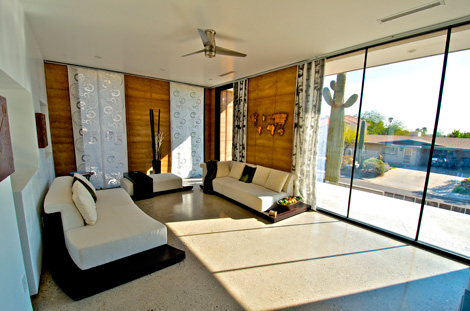
‘The vision for our pad was to design a home that has life and can breathe just as we do and can shape our day-to-day experiences,’ says one owner, an architect. ‘We wanted a home that had an external appearance of being a vertical extension of the desert landscape and internally had minimalism as its core value.’ Aaron Kimberlin image
“The community hosts a diverse landscape of architecture, from tuberculosis cabins in the valleys to multi-story contemporary masterpieces in the mountains,” she explains. “In addition to the prewar examples, one of the most defining characteristics is the extremely small postwar tract homes that were built around the health complex of the hospital.”
People seeking a cure from tuberculosis and asthma first settled the area. “It was hoped that the dry, clean, desert air would cure their illnesses,” Strang explains. “After WWII, it became one of the Valley’s fastest growing areas, with subdivisions replacing tuberculosis camps and middle-class houses pushing out the shacks and tents.”
Midcentury-modern architects drawn to Sunnyslope include Leslie Mahoney, Ralph Haver, Ed Varney and Paul Christian Yeager. Today, the area’s challenging elevations and hillside views have attracted architects and designers such as Marlene Imirzian, James Trahan, Jeffrey Frost, Wendell Burnette and Matthew Trzebiatowski to build their homes and design for others.
Many of these historic and contemporary properties, with sustainable features and modifications to today’s lifestyles, are part of this year’s tour. They include the Vasan-Lobo home, incorporating rammed-earth walls, solar orientation and rainwater harvesting in the original 1911 subdivision, the Frost home, a Haver renovation featuring Energy Star products such as cool roof coating, xeriscaping and intensive recycling efforts and the Gonshorowski home with low-water landscaping.
Businesses are also participating, such as Michael Keele’s Central Slope eco+design+market which will be the second home tour check-in and also hosting an after-hours party.
“Each year, we try to feature both restorations and renovations of midcentury homes,” King explains. “Many of us are struggling with finding a balance between preservation and necessary upgrades to keep this generation of midcentury homes green and livable for our contemporary lifestyle.”
In the 1950s, for example, people didn’t need a home office or media room — a necessity for today’s design professionals. “It’s important to see how other people have accomplished a balance and take ideas and inspiration,” she says. “In the tours, we try to show a good range of ideas at multiple price points by both professionals and weekend warriors, so there’s always a little something for everyone.”
